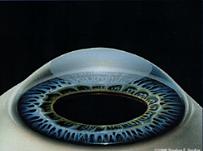Corneal Surgery
 Corneal transplantation, also known as corneal grafting or penetrating keratoplasty (PKP), is a surgical procedure typically performed by an Ophthalmologist with cornea subspecialty training. Parschauer Eye Center is pleased to have Dr. Eric Dudenhoefer and Dr. Kristina Thomas on our staff. They are Opthalmologists who specializes in corneal surgery.
Corneal transplantation, also known as corneal grafting or penetrating keratoplasty (PKP), is a surgical procedure typically performed by an Ophthalmologist with cornea subspecialty training. Parschauer Eye Center is pleased to have Dr. Eric Dudenhoefer and Dr. Kristina Thomas on our staff. They are Opthalmologists who specializes in corneal surgery.
During PKP, a damaged or diseased cornea (the front “window” of the eye), which can no longer transmit light properly to the inner structures of the eye, is replaced by donated homologous corneal tissue. The diseased tissue is surgically removed from the eye and the new, healthy tissue is carefully sewn into place using sutures that are finer than a human hair. This procedure creates a new, clear window in the front of the eye allowing clearer vision to be restored, if the other ocular structures are healthy. Currently over 40,000 PKP’s are performed each year in the United States. Of all organ transplantation performed today, including heart, lungs and kidney, corneal transplantation is by far the most common and successful.
Indications for corneal transplantation include the following:
Optical:
To improve visual acuity by replacing the opaque or ectatic host tissue with clear, healthy donor tisssue.
Tectonic/reconstructive:
To preserve corneal anatomy and integrity in patients with corneal thinning or to reconstruct the anatomy of the eye; e.g., after corneal perforation.
Therapeutic:
To remove inflammed corneal tissue unresponsive to treatment by antibiotics and antivirals.
Cosmetic:
To improve the appearance of patients with corneal scars that have given a whitish or opaque hue to the cornea.
Dr. Dudenhoefer performed the first PKP in the Sandusky area at Firelands Regional Medical Center on February 21, 2007.
Following PKP, visual recovery proceeds at a gradual pace and strenuous physical activity is limited for the first one to two months. Adjustment of the shape of the cornea to improve visual acuity by cutting sutures can begin at three to four months in younger patients; later in the elderly. Ultimately, a visual acuity of 20/20 with the appropriate spectacle or contact lens correction in place would not be unusual. This can often take one year or more.
Due to the immune privileged status of the cornea, HLA matching of the donated tissue is unnecessary. However, graft rejection in the post-operative period can occur anywhere from three months to 40 years after surgery. To prevent this, topical steroid drops are typically all that is necessary for the first one to two years with re-institution of these meds in the future if signs of rejection should present.


